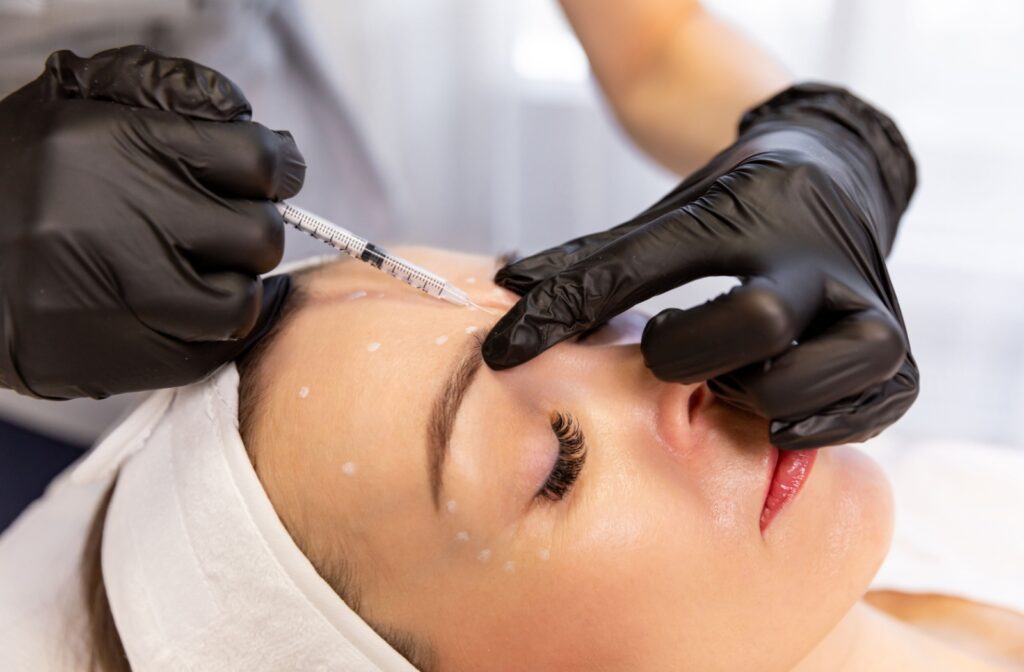As non-surgical cosmetic treatments continue to rise in popularity, many people looking to smooth fine lines and refresh their appearance are faced with a common question: Dysport or Botox—what’s the difference, and which one is right for me?
While both are injectable neuromodulators derived from botulinum toxin and work by relaxing the muscles that cause wrinkles, Dysport tends to spread more and work faster, while Botox offers more precision for smaller treatment zones.
In this guide, we’ll break down what sets Dysport and Botox apart, explore their pros and cons, and help you make an informed decision about which treatment might be the better fit for your needs.
What’s the Difference Between Dysport & Botox?
Botox and Dysport both contain botulinum toxin type A and work in similar ways: they temporarily block nerve signals to targeted muscles, reducing their activity and softening the appearance of dynamic wrinkles caused by facial expressions.
However, there are subtle but important differences in how they’re formulated and how they behave under the skin:
- Dysport is more diluted than Botox, meaning more units are needed to achieve similar results.
- Dysport spreads more easily once injected, making it ideal for treating larger areas, like the forehead.
- Botox is more concentrated and precise, making it well-suited for smaller treatment zones or more defined wrinkle lines.
Where Each Treatment Shines
Dysport is currently approved in Canada for the treatment of glabellar lines—those vertical frown lines between the eyebrows. Because it spreads quickly under the skin, Dysport may work faster and cover larger areas more evenly. People looking for a more diffuse, natural-looking result in a larger treatment area may benefit from Dysport’s wider diffusion.
Botox, on the other hand, is approved to treat a broader range of cosmetic concerns, including crow’s feet, forehead lines, and bunny lines on the nose. Its targeted action makes it better suited for fine detail work and small areas requiring precision.
How Long Do Results Last?
Both Botox and Dysport offer temporary results, with effects typically lasting 4 to 6 months. However, individual results vary based on your metabolism, treatment area, and the number of units used.
Some patients report that Botox may last a bit longer in smaller, concentrated areas, while Dysport may take effect slightly faster, often within 2–3 days compared to Botox’s average 4–7 days.
If you are seeking a quick turnaround before an event, Dysport might be the better option. But if longevity is more important than speed, Botox could be worth the wait.
Cost Comparison: Is Dysport Cheaper?
At first glance, Dysport often seems less expensive than Botox on a per-unit basis. However, Dysport dilution can differ from Botox dilution, causing more product to be required.
This means that the overall cost for equivalent treatment results may be similar, though pricing depends on your provider’s rates and how much product is needed for your specific concerns.
Pros & Cons of Dysport
Pros of Dysport:
- Often more affordable per unit
- Faster onset of results
- Less risk of a “frozen” look in larger areas
- May cause fewer side effects
Cons of Dysport:
- Less ideal for small, targeted areas
- May wear off slightly faster than Botox
Pros & Cons of Botox
Pros of Botox:
- Approved for multiple cosmetic uses
- Ideal for small, precise treatment areas
- May offer slightly longer-lasting results
- More practitioners are experienced with Botox
Cons of Botox:
- More expensive per unit
- Takes longer for results to appear
- Slightly higher chance of minor side effects like bruising or swelling
Which One Should You Choose?
The right choice between Dysport and Botox depends on several factors:
- Your treatment goals: Want a subtle softening of forehead lines or need precision around the eyes? Botox may be better. Looking to smooth a broad area like glabellar lines quickly? Dysport may deliver results faster.
- Your timeline: If you need quick results for a special occasion, Dysport might work better on a short timeline.
- Your budget: Dysport may offer a cost advantage per treatment in larger areas, but the final cost often evens out.
- Your provider’s recommendation: Your provider’s comfort level and experience with either injectable can influence the outcome. Some injectors may prefer one over the other based on your anatomy or skin type.
Regardless of the product, the skill and expertise of your provider are just as—if not more—important than the brand you choose.

Combining Both Treatments
Some practitioners may even use a combination of Botox and Dysport, depending on your treatment plan and facial anatomy. For example, Botox might be used around the eyes, while Dysport is used for glabellar or forehead lines. A personalized consultation is the best way to determine what approach is ideal for you.
Book a Consultation Today
If you’re considering a cosmetic injectable to reduce wrinkles and rejuvenate your appearance, our team at Hometown Dental in Okotoks can help. We offer advanced, safe, and customized injectable treatments—including both Dysport and Botox—to meet your goals with precision and care. Book your consultation today to learn more about your options and take the next step toward refreshed, confident skin.





